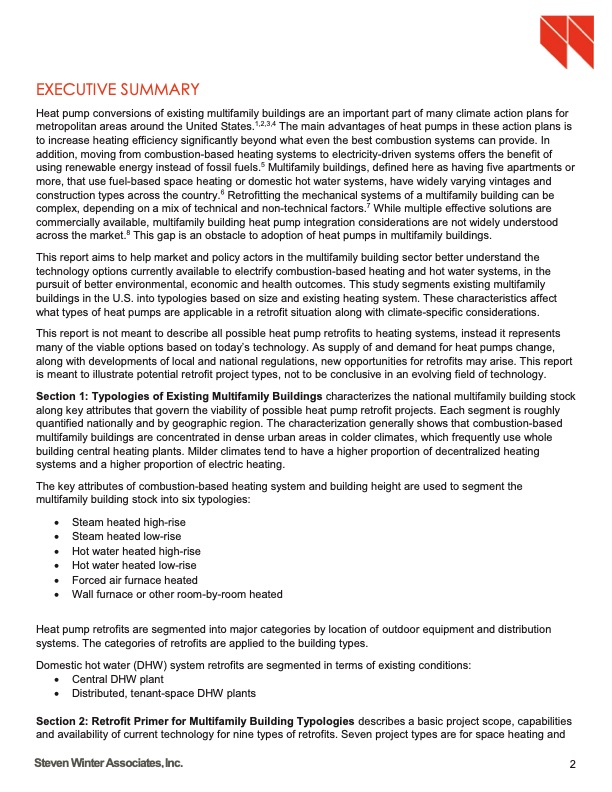
PDF Publication Title:
Text from PDF Page: 002
EXECUTIVE SUMMARY Heat pump conversions of existing multifamily buildings are an important part of many climate action plans for metropolitan areas around the United States.1,2,3,4 The main advantages of heat pumps in these action plans is to increase heating efficiency significantly beyond what even the best combustion systems can provide. In addition, moving from combustion-based heating systems to electricity-driven systems offers the benefit of using renewable energy instead of fossil fuels.5 Multifamily buildings, defined here as having five apartments or more, that use fuel-based space heating or domestic hot water systems, have widely varying vintages and construction types across the country.6 Retrofitting the mechanical systems of a multifamily building can be complex, depending on a mix of technical and non-technical factors.7 While multiple effective solutions are commercially available, multifamily building heat pump integration considerations are not widely understood across the market.8 This gap is an obstacle to adoption of heat pumps in multifamily buildings. This report aims to help market and policy actors in the multifamily building sector better understand the technology options currently available to electrify combustion-based heating and hot water systems, in the pursuit of better environmental, economic and health outcomes. This study segments existing multifamily buildings in the U.S. into typologies based on size and existing heating system. These characteristics affect what types of heat pumps are applicable in a retrofit situation along with climate-specific considerations. This report is not meant to describe all possible heat pump retrofits to heating systems, instead it represents many of the viable options based on today’s technology. As supply of and demand for heat pumps change, along with developments of local and national regulations, new opportunities for retrofits may arise. This report is meant to illustrate potential retrofit project types, not to be conclusive in an evolving field of technology. Section 1: Typologies of Existing Multifamily Buildings characterizes the national multifamily building stock along key attributes that govern the viability of possible heat pump retrofit projects. Each segment is roughly quantified nationally and by geographic region. The characterization generally shows that combustion-based multifamily buildings are concentrated in dense urban areas in colder climates, which frequently use whole building central heating plants. Milder climates tend to have a higher proportion of decentralized heating systems and a higher proportion of electric heating. The key attributes of combustion-based heating system and building height are used to segment the multifamily building stock into six typologies: � Steam heated high-rise � Steam heated low-rise � Hot water heated high-rise � Hot water heated low-rise � Forced air furnace heated � Wall furnace or other room-by-room heated Heat pump retrofits are segmented into major categories by location of outdoor equipment and distribution systems. The categories of retrofits are applied to the building types. Domestic hot water (DHW) system retrofits are segmented in terms of existing conditions: � Central DHW plant � Distributed, tenant-space DHW plants Section 2: Retrofit Primer for Multifamily Building Typologies describes a basic project scope, capabilities and availability of current technology for nine types of retrofits. Seven project types are for space heating and Steven Winter Associates,Inc. 2PDF Image | HEAT PUMP RETROFIT STRATEGIES FOR MULTIFAMILY BUILDINGS

PDF Search Title:
HEAT PUMP RETROFIT STRATEGIES FOR MULTIFAMILY BUILDINGSOriginal File Name Searched:
heat-pump-retrofit-strategies-report-05082019.pdfDIY PDF Search: Google It | Yahoo | Bing
CO2 Organic Rankine Cycle Experimenter Platform The supercritical CO2 phase change system is both a heat pump and organic rankine cycle which can be used for those purposes and as a supercritical extractor for advanced subcritical and supercritical extraction technology. Uses include producing nanoparticles, precious metal CO2 extraction, lithium battery recycling, and other applications... More Info
Heat Pumps CO2 ORC Heat Pump System Platform More Info
| CONTACT TEL: 608-238-6001 Email: greg@infinityturbine.com | RSS | AMP |